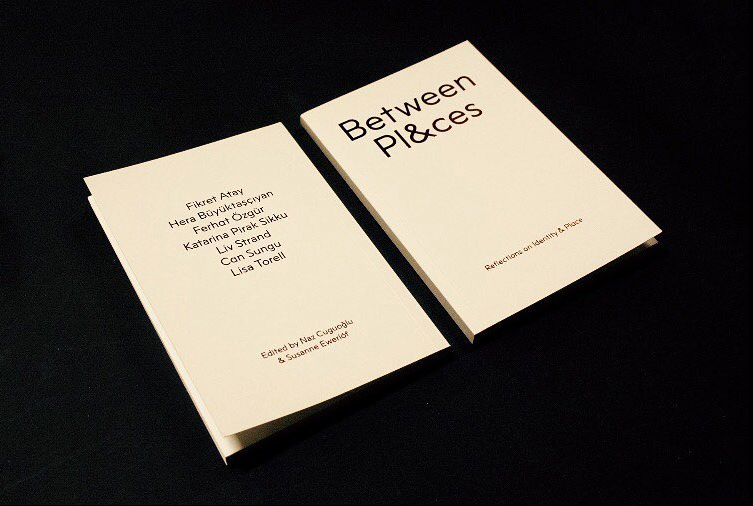
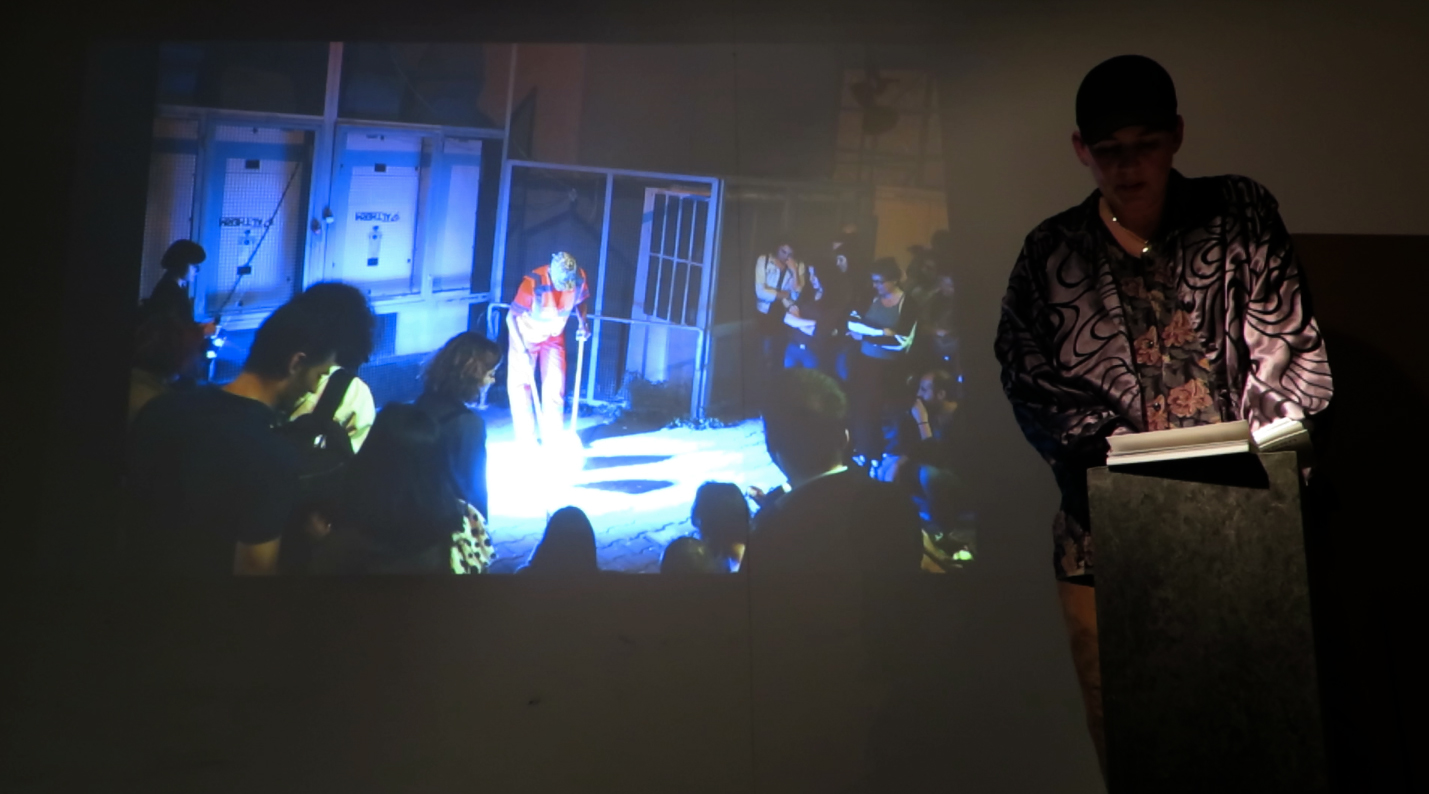
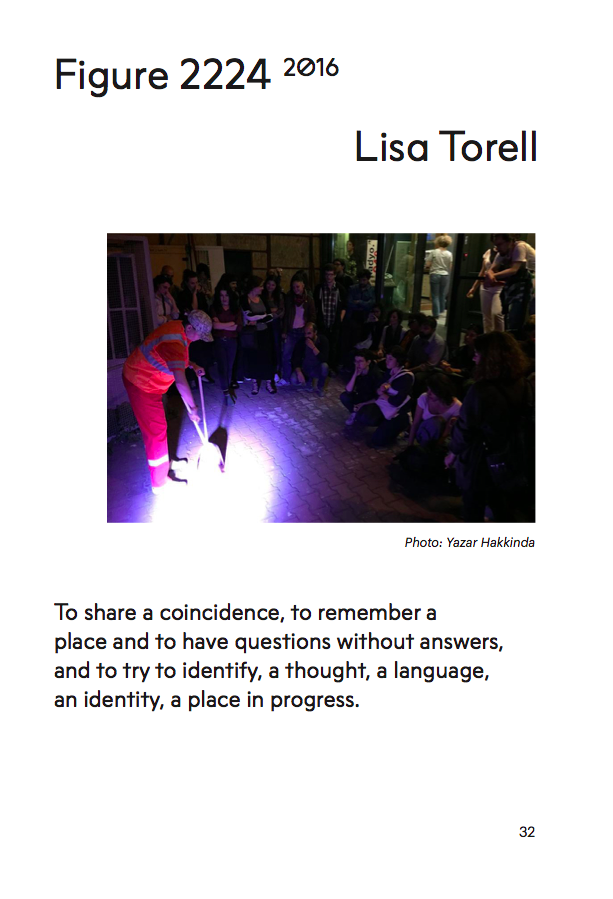
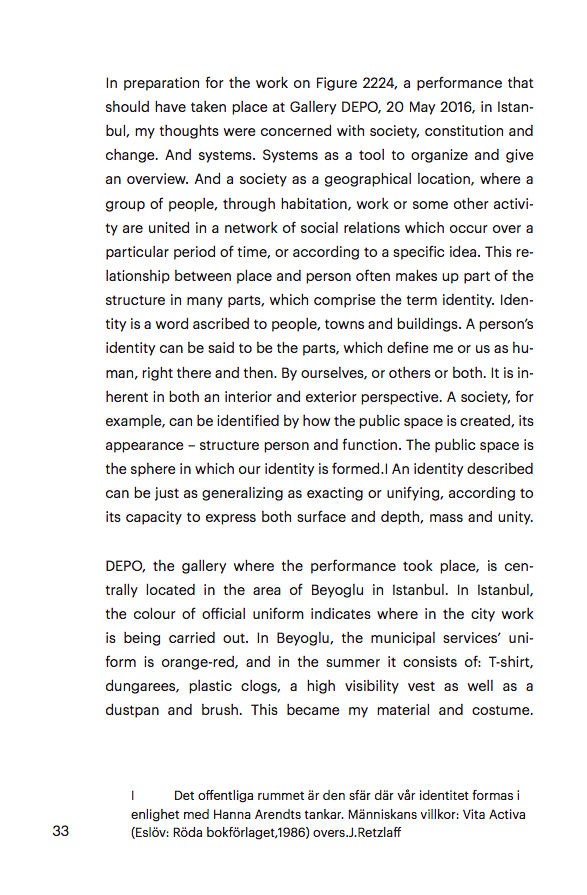
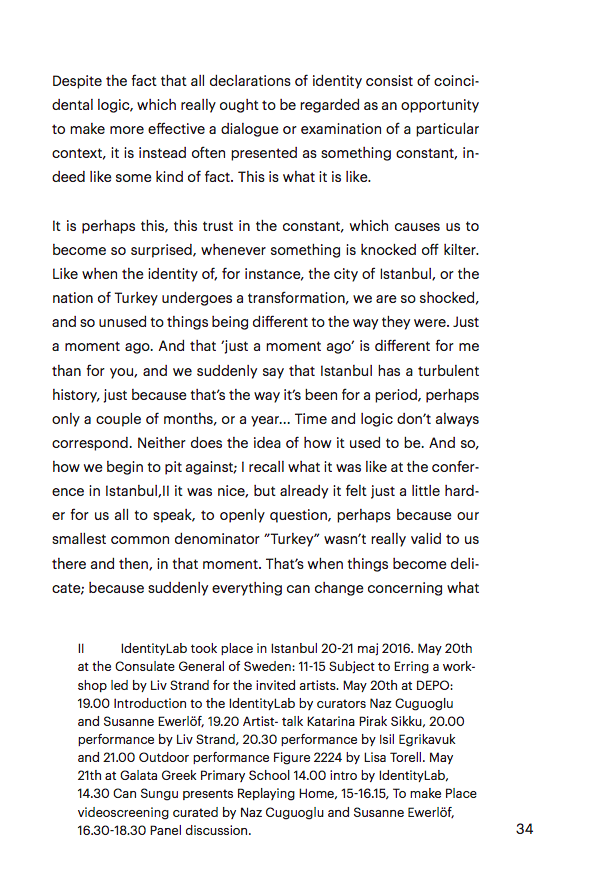
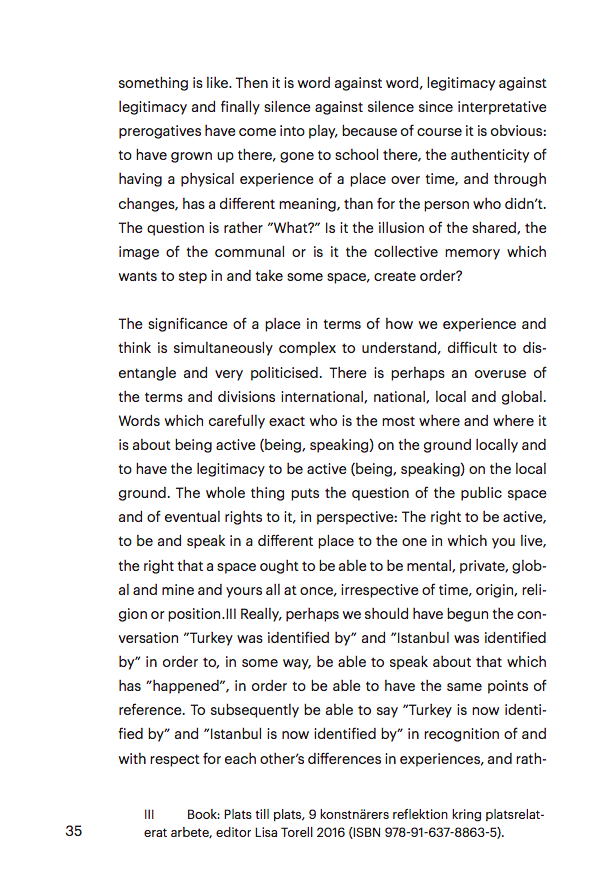
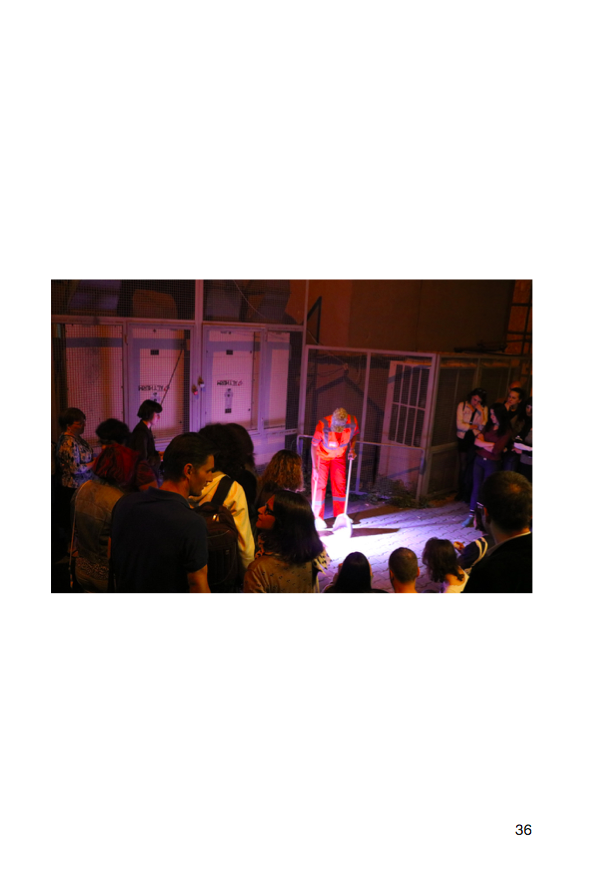
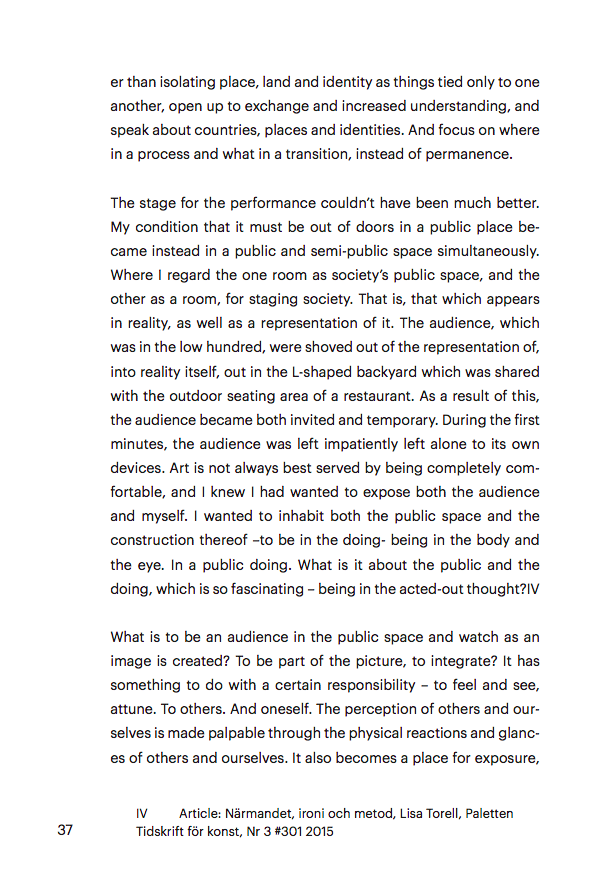
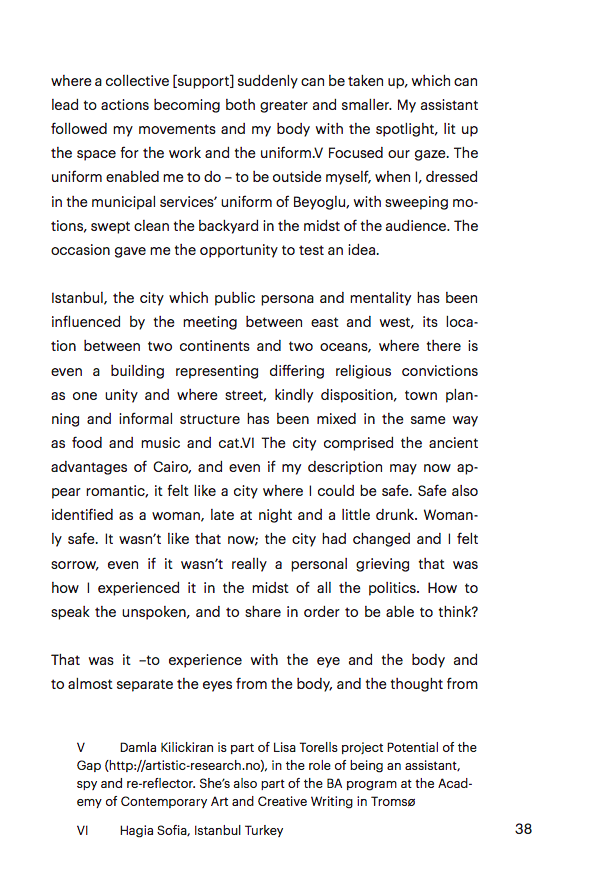
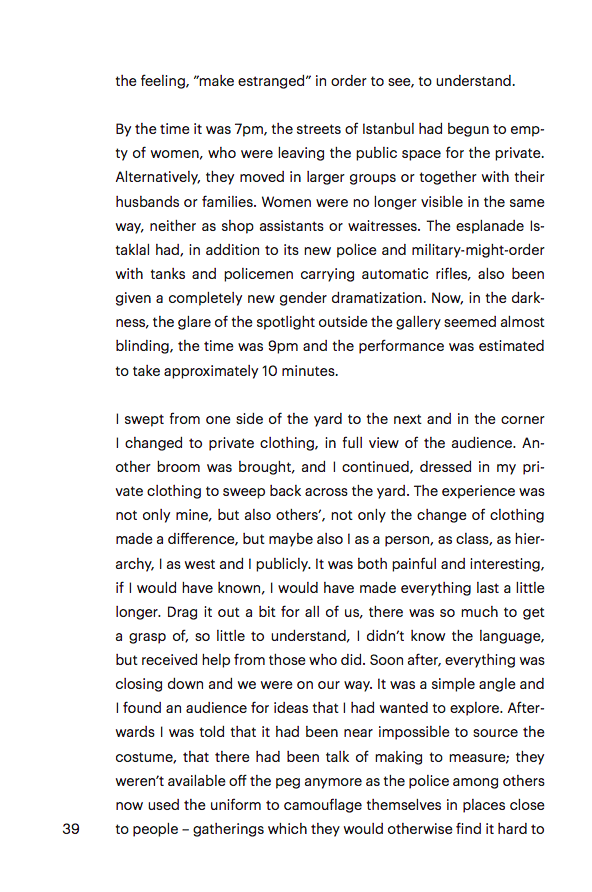
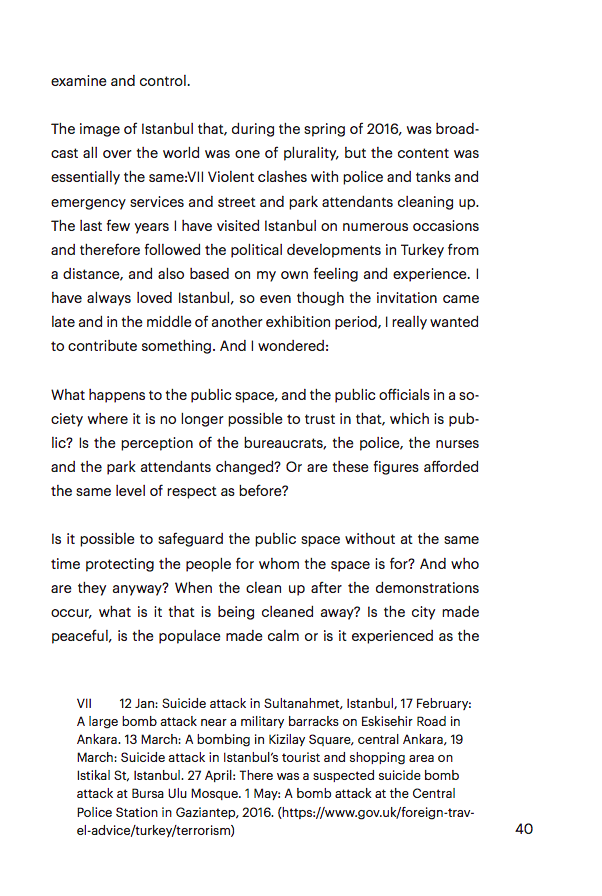
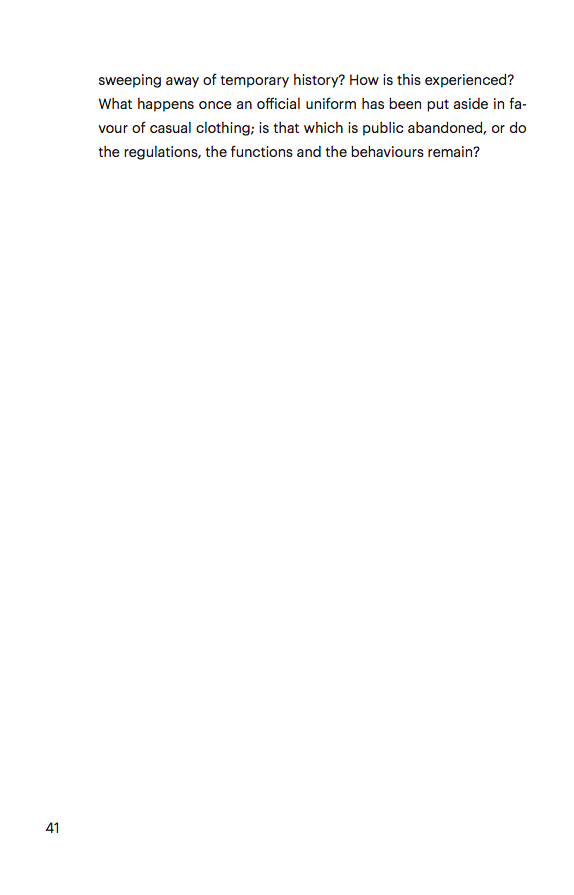
...
.................................. ..................
Lisa Torell
works
biography
other works
contact
________________________________________________________________________________________________________
BETWEEN PL&ACES
Reflections on idenitity and place
(2016)
Editor: Naz Cuguoglu and Susanne Ewerlöf
Design Erik Månsson
Contributors: Fikret Atay, Hera Büyüktasçiyan, Ferhat Özgür, Katarina Pirak Sikku, Liv Strand, Can Sungu and Lisa Torell.
An anthology compiling reflections about how identity is made and performed through the movement of the self and/or experiences of places under transformation. Parts of the book is directly or indirectly relating to the artistic research project IdentityLab that was initiated by Cuguo?lu and Ewerlöf and was executed in Sweden and Turkey in 2016.
Exhanging Notes on Identity & Places
Susanne Ewerlöf, Naz Cugouglu, Liv strand and Can Sungu p.8
Figure 2224
Lisa Torell, p.34
Badjelántta Louttat(Traces from the Land above)
Katarina Pirak Sikku, p.44
Geography, Migration & Dressing Policy
Ferhat Özgür, p.54
Conversation with Fikret Atay
Susanne Ewerlöf, Naz Cugouglu and Fikret Atay, p.62
Revoulutions break out on ships & utopias are lived on islands
Hera Büyüktasçiyan, p.68
It had its Swedish release at Konstfrämjandet December 5, 18-19.30 Konstfrämjandet, Swedenborgsgatan 1, Stockholm with Susanne Ewerlöf, Liv Strand and Lisa Torell and will have its Turkish release at gallery ALT ART SPACE in Istanbul 8th January 2017.
..............................................................................
Lisa Torell,
Figure 2224 (2016)
To share a coincidence, to remember a place and to have questions without answers, and to try to identify, a thought, a language, an identity, a place in progress.
In preparation for the work on Figure 2224, a performance that should have taken place at Gallery DEPO, 20 May 2016, in Istanbul, my thoughts were concerned with society, constitution and change. And systems. Systems as a tool to organise and give an overview. And a society as a geographical location, where a group of people, through habitation, work or some other activity are united in a network of social relations which occur over a particular period of time, or according to a specific idea. This relationship between place and person often makes up part of the structure in many parts, which comprise the term identity. Identity is a word ascribed to people, towns and buildings. A person’s identity can be said to be the parts, which define me or us as human, right there and then. By ourselves, or others or both. It is inherent in both an interior and exterior perspective. A society, for example, can be identified by how the public space is created, its appearance – structure person and function. The public space is the sphere in which our identity is forme. An identity described can be just as generalising as exacting or unifying, according to its capacity to express both surface and depth, mass and unity.
DEPO, the gallery where the performance took place, is centrally located in the area of Beyoglu in Istanbul. In Istanbul, the colour of official uniform indicates where in the city work is being carried out. In Beyoglu, the municipal services’ uniform is orange-red, and in the summer it consists of: T-shirt, dungarees, plastic clogs, a high visibility vest as well as a dustpan and brush.This became my material and costume.
Despite the fact that all declarations of identity consist of coincidental logic, which really ought to be regarded as an opportunity to make more effective a dialogue or examination of a particular context, it is instead often presented as something constant, indeed like some kind of fact. This is what it is like.
It is perhaps this, this trust in the constant, which causes us to become so surprised, whenever something is knocked off kilter. Like when the identity of, for instance, the city of Istanbul, or the nation of Turkey undergoes a transformation, we are so shocked, and so unused to things being different to the way they were. Just a moment ago.
And that ’just a moment ago’ is different for me than for you, and we suddenly say that Istanbul has a turbulent history, just because that’s the way it’s been for a period, perhaps only a couple of months, or a year... Time and logic don’t always correspond. Neither does the idea of how it used to be. And so, how we begin to pit against; I recall what it was like at the conference in Istanbul, it was nice, but already it felt just a little harder for us all to speak, to openly question, perhaps because our smallest common denominator ”Turkey” wasn’t really valid to us there and then, in that moment. That’s when things become delicate; because suddenly everything can change concerning what something is like. Then it is word against word, legitimacy against legitimacy and finally silence against silence since interpretative prerogatives have come into play, because of course it is obvious: to have grown up there, gone to school there, the authenticity of having a physical experience of a place over time, and through changes, has a different meaning, than for the person who didn’t. The question is rather ”What?” Is it the illusion of the shared, the image of the communal or is it the collective memory which wants to step in and take some space, create order?
The significance of a place in terms of how we experience and think is simultaneously complex to understand, difficult to disentangle and very politicised. There is perhaps an overuse of the terms and divisions international, national, local and global. Words which carefully exact who is the most where and where it is about being active (being, speaking) on the ground locally and to have the legitimacy to be active (being, speaking) on the local ground. The whole thing puts the question of the public space and of eventual rights to it, in perspective: The right to be active, to be and speak in a different place to the one in which you live, the right that a space ought to be able to be mental, private, global and mine and yours all at once, irrespective of time, origin, religion or position. Really, perhaps we should have begun the conversation ”Turkey was identified by” and ”Istanbul was identified by” in order to, in some way, be able to speak about that which has ”happened”, in order to be able to have the same points of reference. To subsequently be able to say ”Turkey is now identified by” and ”Istanbul is now identified by” in recognition of and with respect for each other’s differences in experiences, and rather than isolating place, land and identity as things tied only to one another, open up to exchange and increased understanding, and speak about countries, places and identities. And focus on where in a process and what in a transition, instead of permanence.
The stage for the performance couldn’t have been much better. My condition that it must be out of doors in a public place became instead in a public and semi-public space simultaneously. Where I regard the one room as society’s public space, and the other as a room, for staging society. That is, that which appears in reality, as well as a representation of it. The audience, which was in the low hundred, were shoved out of the representation of, into reality itself, out in the L-shaped backyard which was shared with the outdoor seating area of a restaurant. As a result of this, the audience became both invited and temporary. During the first minutes, the audience was left impatiently left alone to its own devices. Art is not always best served by being completely comfortable, and I knew I had wanted to expose both the audience and myself. I wanted to inhabit both the public space and the construction thereof –to be in the doing- being in the body and the eye. In a public doing. What is it about the public and the doing, which is so fascinating – being in the acted-out thought?
What is to be an audience in the public space and watch as an image is created? To be part of the picture, to integrate? It has something to do with a certain responsibility –to feel and see, attune. To others. And oneself. The perception of others and ourselves is made palpable through the physical reactions and glances of others and ourselves. It also becomes a place for exposure, where a collective [support] suddenly can be taken up, which can lead to actions becoming both greater and smaller. My assistant followed my movements and my body with the spotlight, lit up the space for the work and the uniform. Focussed our gaze. The uniform enabled me to do –to be outside myself, when I, dressed in the municipal services’ uniform of Beyoglu, with sweeping motions, swept clean the backyard in the midst of the audience. The occasion gave me the opportunity to test an idea.
Istanbul, the city which public persona and mentality has been influenced by the meeting between east and west, its location between two continents and two oceans, where there is even a building representing differing religious convictions as one unity and where street, kindly disposition, town planning and informal structure has been mixed in the same way as food and music and cat. The city comprised the ancient advantages of Cairo, and even if my description may now appear romantic, it felt like a city where I could be safe. Safe also identified as a woman, late at night and a little drunk. Womanly safe. It wasn’t like that now, the city had changed and I felt sorrow, even if it wasn’t really a personal grieving that was how I experienced it in the midst of all the politics. How to speak the unspoken, and to share in order to be able to think?
That was it –to experience with the eye and the body and to almost separate the eyes from the body, and the thought from the feeling, ”make estranged” in order to see, to understand.
By the time it was 7pm, the streets of Istanbul had begun to empty of women, who were leaving the public space for the private. Alternatively, they moved in larger groups or together with their husbands or families. Women were no longer visible in the same way, neither as shop assistants or waitresses. The esplanade Istaklar had, in addition to its new police and military-might-order with tanks and policemen carrying automatic rifles, also been given a completely new gender dramatization. Now, in the darkness, the glare of the spotlight outside the gallery seemed almost blinding, the time was 9pm and the performance was estimated to take approximately 10 minutes.
I swept from one side of the yard to the next and in the corner I changed to private clothing, in full view of the audience. Another broom was brought, and I continued, dressed in my private clothing to sweep back across the yard. The experience was not only mine, but also others’, not only the change of clothing made a difference, but maybe alsoI as a person, as class, as hierarchy, I as west and I publicly. It was both painful and interesting, if I would have known, I would have made everything last a little longer. Drag it out a bit for all of us, there was so much to get a grasp of, so little to understand, I didn’t know the language, but received help from those who did. Soon after, everything was closing down and we were on our way. It was a simple angle and I found an audience for ideas that I had wanted to explore. Afterwards I was told that it had been near impossible to source the costume, that there had been talk of making to measure; they weren’t available off the peg anymore as the police among others now used the uniform to camouflage themselves in places close to people –gatherings which they would otherwise find it hard to examine and control.
The image of Istanbul that, during the spring of 2016, was broadcast all over the world was one of plurality, but the content was essentially the same: Violent clashes with police and tanks and emergency services and street and park attendants cleaning up. The last few years I have visited Istanbul on numerous occasions and therefore followed the political developments in Turkey from a distance, and also based on my own feeling and experience. I have always loved Istanbul, so even though the invitation came late and in the middle of another exhibition period, I really wanted to contribute something. And I wondered:
- What happens to the public space, and the public officials in a society where it is no longer possible to trust in that, which is public? Is the perception of the bureaucrats, the police, the nurses and the park attendants changed? Or are these figures afforded the same level of respect as before?Is it possible to safeguard the public space without at the same time protecting the people for whom the space is for? And who are they anyway?
- When the clean up after the demonstrations occur, what is it that is being cleaned away? Is the city made peaceful, is the populace made calm or is it experienced as the sweeping away of temporary history? How is this experienced?
- What happens once an official uniform has been put aside in favour of casual clothing; is that which is public abandoned, or do the regulations, the functions and the behaviours remain?












...
.................................. ..................